Analysis of Cell Phones' Effectiveness as Ubiquitous Computing Devices
VerifiedAdded on 2020/06/06
|9
|2547
|83
Report
AI Summary
This report evaluates cell phones as ubiquitous computing mobile devices, assessing their effectiveness and associated challenges. It begins with an introduction to ubiquitous computing, highlighting its aim to make computing accessible anytime, anywhere, and then outlines objectives including analyzing the concept, determining effectiveness, and evaluating challenges. A review section discusses the benefits of cell phones in this context, such as enhanced speed, cost efficiency, and accessibility, while also addressing security risks like hacking and data encryption vulnerabilities, as well as usability issues. The report then delves into human-computer interaction (HCI) aspects and the essential features of cell phones as ubiquitous devices, including accumulators and networking technologies. It compares cell phones to desktop computers, emphasizing the flexibility and reduced complexity of the former. Finally, it concludes that cell phones are a significant advancement in ubiquitous computing, while acknowledging the need for security measures and battery support. The report emphasizes the ethical considerations and the impact of cell phones on various aspects of modern life, such as home deliveries and communication.
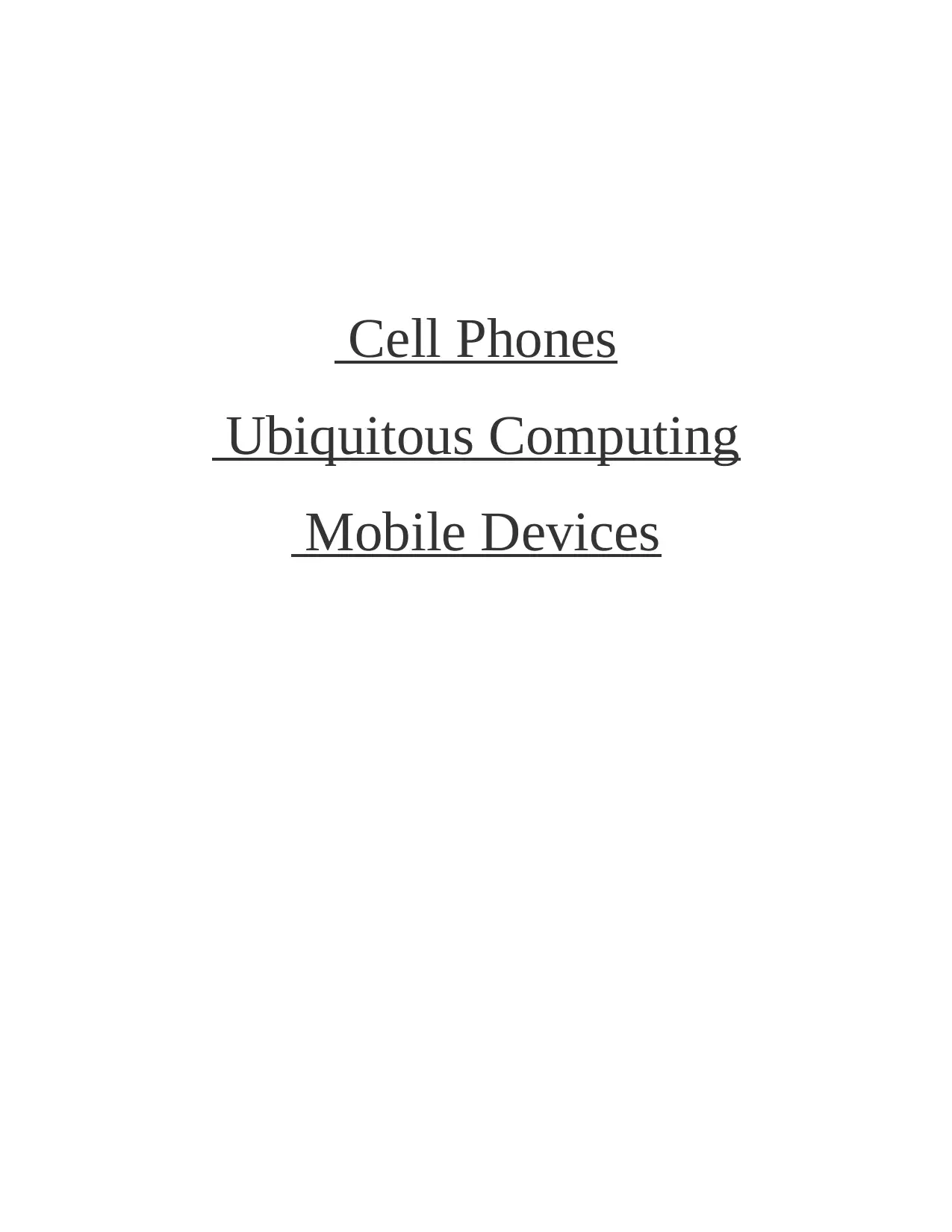
Cell Phones
Ubiquitous Computing
Mobile Devices
Ubiquitous Computing
Mobile Devices
Paraphrase This Document
Need a fresh take? Get an instant paraphrase of this document with our AI Paraphraser

TABLE OF CONTENTS
INTRODUCTION...........................................................................................................................1
Aim .................................................................................................................................................1
Objectives........................................................................................................................................1
Review ........................................................................................................................................1
Discussion...................................................................................................................................3
CONCLUSION ...............................................................................................................................5
REFERENCES................................................................................................................................6
INTRODUCTION...........................................................................................................................1
Aim .................................................................................................................................................1
Objectives........................................................................................................................................1
Review ........................................................................................................................................1
Discussion...................................................................................................................................3
CONCLUSION ...............................................................................................................................5
REFERENCES................................................................................................................................6
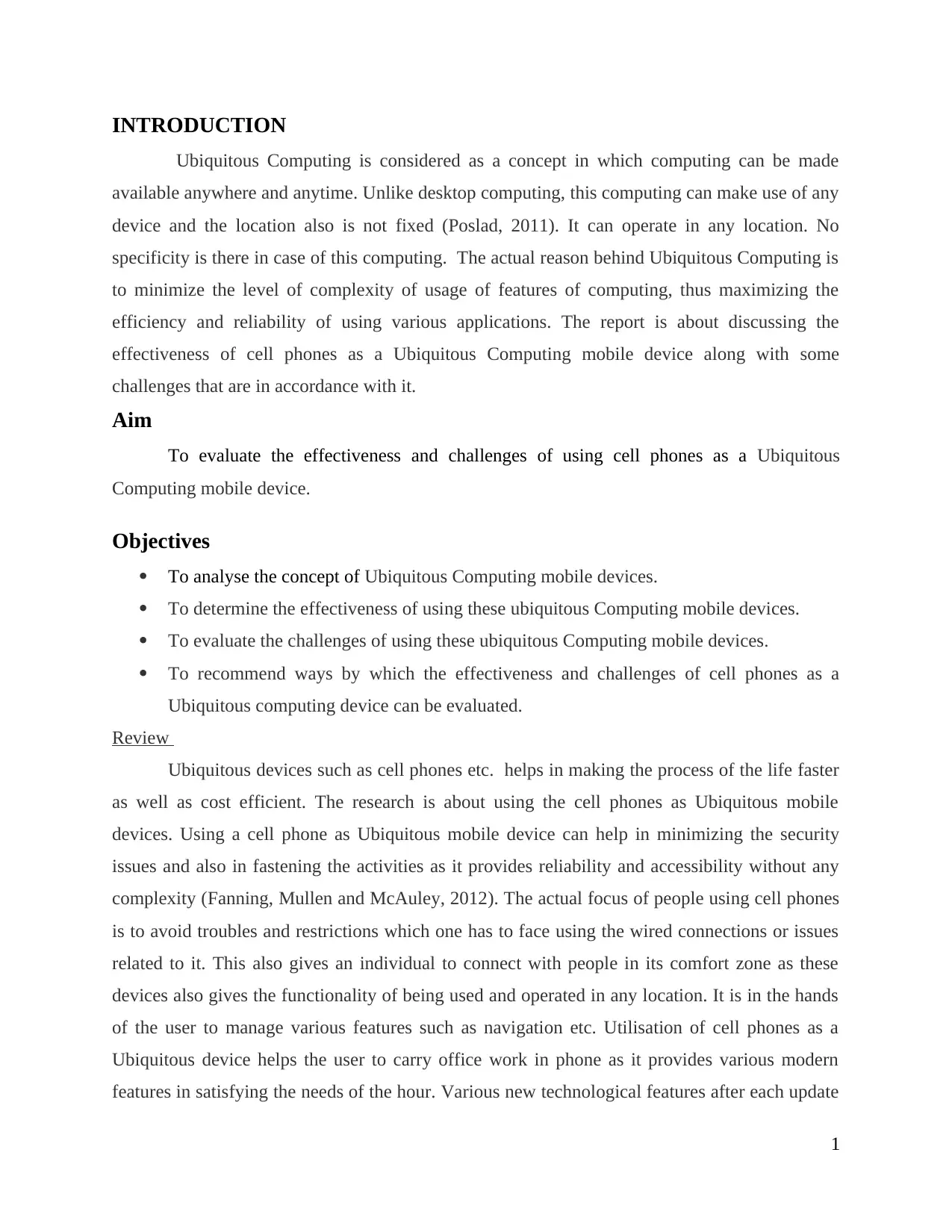
INTRODUCTION
Ubiquitous Computing is considered as a concept in which computing can be made
available anywhere and anytime. Unlike desktop computing, this computing can make use of any
device and the location also is not fixed (Poslad, 2011). It can operate in any location. No
specificity is there in case of this computing. The actual reason behind Ubiquitous Computing is
to minimize the level of complexity of usage of features of computing, thus maximizing the
efficiency and reliability of using various applications. The report is about discussing the
effectiveness of cell phones as a Ubiquitous Computing mobile device along with some
challenges that are in accordance with it.
Aim
To evaluate the effectiveness and challenges of using cell phones as a Ubiquitous
Computing mobile device.
Objectives
To analyse the concept of Ubiquitous Computing mobile devices.
To determine the effectiveness of using these ubiquitous Computing mobile devices.
To evaluate the challenges of using these ubiquitous Computing mobile devices.
To recommend ways by which the effectiveness and challenges of cell phones as a
Ubiquitous computing device can be evaluated.
Review
Ubiquitous devices such as cell phones etc. helps in making the process of the life faster
as well as cost efficient. The research is about using the cell phones as Ubiquitous mobile
devices. Using a cell phone as Ubiquitous mobile device can help in minimizing the security
issues and also in fastening the activities as it provides reliability and accessibility without any
complexity (Fanning, Mullen and McAuley, 2012). The actual focus of people using cell phones
is to avoid troubles and restrictions which one has to face using the wired connections or issues
related to it. This also gives an individual to connect with people in its comfort zone as these
devices also gives the functionality of being used and operated in any location. It is in the hands
of the user to manage various features such as navigation etc. Utilisation of cell phones as a
Ubiquitous device helps the user to carry office work in phone as it provides various modern
features in satisfying the needs of the hour. Various new technological features after each update
1
Ubiquitous Computing is considered as a concept in which computing can be made
available anywhere and anytime. Unlike desktop computing, this computing can make use of any
device and the location also is not fixed (Poslad, 2011). It can operate in any location. No
specificity is there in case of this computing. The actual reason behind Ubiquitous Computing is
to minimize the level of complexity of usage of features of computing, thus maximizing the
efficiency and reliability of using various applications. The report is about discussing the
effectiveness of cell phones as a Ubiquitous Computing mobile device along with some
challenges that are in accordance with it.
Aim
To evaluate the effectiveness and challenges of using cell phones as a Ubiquitous
Computing mobile device.
Objectives
To analyse the concept of Ubiquitous Computing mobile devices.
To determine the effectiveness of using these ubiquitous Computing mobile devices.
To evaluate the challenges of using these ubiquitous Computing mobile devices.
To recommend ways by which the effectiveness and challenges of cell phones as a
Ubiquitous computing device can be evaluated.
Review
Ubiquitous devices such as cell phones etc. helps in making the process of the life faster
as well as cost efficient. The research is about using the cell phones as Ubiquitous mobile
devices. Using a cell phone as Ubiquitous mobile device can help in minimizing the security
issues and also in fastening the activities as it provides reliability and accessibility without any
complexity (Fanning, Mullen and McAuley, 2012). The actual focus of people using cell phones
is to avoid troubles and restrictions which one has to face using the wired connections or issues
related to it. This also gives an individual to connect with people in its comfort zone as these
devices also gives the functionality of being used and operated in any location. It is in the hands
of the user to manage various features such as navigation etc. Utilisation of cell phones as a
Ubiquitous device helps the user to carry office work in phone as it provides various modern
features in satisfying the needs of the hour. Various new technological features after each update
1
⊘ This is a preview!⊘
Do you want full access?
Subscribe today to unlock all pages.

Trusted by 1+ million students worldwide
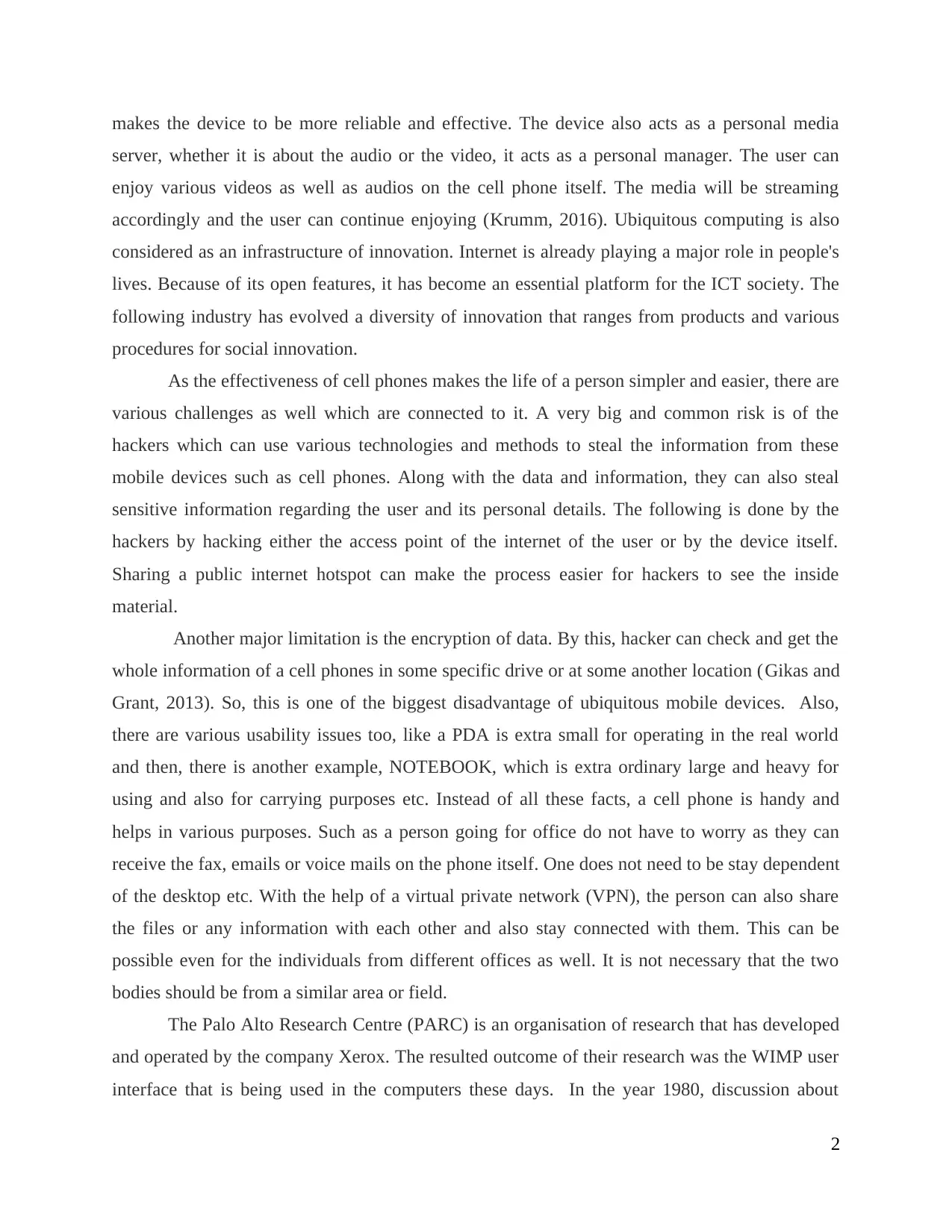
makes the device to be more reliable and effective. The device also acts as a personal media
server, whether it is about the audio or the video, it acts as a personal manager. The user can
enjoy various videos as well as audios on the cell phone itself. The media will be streaming
accordingly and the user can continue enjoying (Krumm, 2016). Ubiquitous computing is also
considered as an infrastructure of innovation. Internet is already playing a major role in people's
lives. Because of its open features, it has become an essential platform for the ICT society. The
following industry has evolved a diversity of innovation that ranges from products and various
procedures for social innovation.
As the effectiveness of cell phones makes the life of a person simpler and easier, there are
various challenges as well which are connected to it. A very big and common risk is of the
hackers which can use various technologies and methods to steal the information from these
mobile devices such as cell phones. Along with the data and information, they can also steal
sensitive information regarding the user and its personal details. The following is done by the
hackers by hacking either the access point of the internet of the user or by the device itself.
Sharing a public internet hotspot can make the process easier for hackers to see the inside
material.
Another major limitation is the encryption of data. By this, hacker can check and get the
whole information of a cell phones in some specific drive or at some another location (Gikas and
Grant, 2013). So, this is one of the biggest disadvantage of ubiquitous mobile devices. Also,
there are various usability issues too, like a PDA is extra small for operating in the real world
and then, there is another example, NOTEBOOK, which is extra ordinary large and heavy for
using and also for carrying purposes etc. Instead of all these facts, a cell phone is handy and
helps in various purposes. Such as a person going for office do not have to worry as they can
receive the fax, emails or voice mails on the phone itself. One does not need to be stay dependent
of the desktop etc. With the help of a virtual private network (VPN), the person can also share
the files or any information with each other and also stay connected with them. This can be
possible even for the individuals from different offices as well. It is not necessary that the two
bodies should be from a similar area or field.
The Palo Alto Research Centre (PARC) is an organisation of research that has developed
and operated by the company Xerox. The resulted outcome of their research was the WIMP user
interface that is being used in the computers these days. In the year 1980, discussion about
2
server, whether it is about the audio or the video, it acts as a personal manager. The user can
enjoy various videos as well as audios on the cell phone itself. The media will be streaming
accordingly and the user can continue enjoying (Krumm, 2016). Ubiquitous computing is also
considered as an infrastructure of innovation. Internet is already playing a major role in people's
lives. Because of its open features, it has become an essential platform for the ICT society. The
following industry has evolved a diversity of innovation that ranges from products and various
procedures for social innovation.
As the effectiveness of cell phones makes the life of a person simpler and easier, there are
various challenges as well which are connected to it. A very big and common risk is of the
hackers which can use various technologies and methods to steal the information from these
mobile devices such as cell phones. Along with the data and information, they can also steal
sensitive information regarding the user and its personal details. The following is done by the
hackers by hacking either the access point of the internet of the user or by the device itself.
Sharing a public internet hotspot can make the process easier for hackers to see the inside
material.
Another major limitation is the encryption of data. By this, hacker can check and get the
whole information of a cell phones in some specific drive or at some another location (Gikas and
Grant, 2013). So, this is one of the biggest disadvantage of ubiquitous mobile devices. Also,
there are various usability issues too, like a PDA is extra small for operating in the real world
and then, there is another example, NOTEBOOK, which is extra ordinary large and heavy for
using and also for carrying purposes etc. Instead of all these facts, a cell phone is handy and
helps in various purposes. Such as a person going for office do not have to worry as they can
receive the fax, emails or voice mails on the phone itself. One does not need to be stay dependent
of the desktop etc. With the help of a virtual private network (VPN), the person can also share
the files or any information with each other and also stay connected with them. This can be
possible even for the individuals from different offices as well. It is not necessary that the two
bodies should be from a similar area or field.
The Palo Alto Research Centre (PARC) is an organisation of research that has developed
and operated by the company Xerox. The resulted outcome of their research was the WIMP user
interface that is being used in the computers these days. In the year 1980, discussion about
2
Paraphrase This Document
Need a fresh take? Get an instant paraphrase of this document with our AI Paraphraser
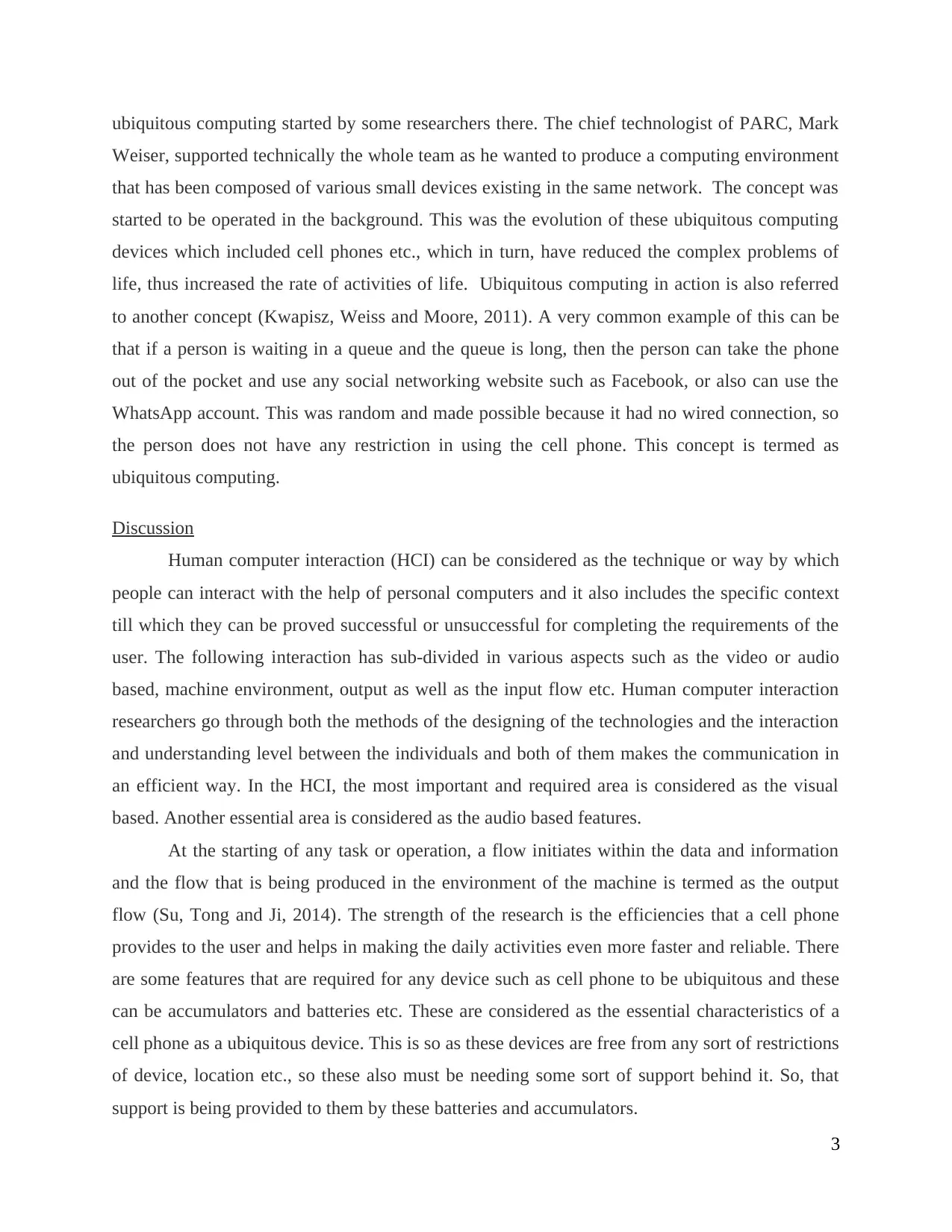
ubiquitous computing started by some researchers there. The chief technologist of PARC, Mark
Weiser, supported technically the whole team as he wanted to produce a computing environment
that has been composed of various small devices existing in the same network. The concept was
started to be operated in the background. This was the evolution of these ubiquitous computing
devices which included cell phones etc., which in turn, have reduced the complex problems of
life, thus increased the rate of activities of life. Ubiquitous computing in action is also referred
to another concept (Kwapisz, Weiss and Moore, 2011). A very common example of this can be
that if a person is waiting in a queue and the queue is long, then the person can take the phone
out of the pocket and use any social networking website such as Facebook, or also can use the
WhatsApp account. This was random and made possible because it had no wired connection, so
the person does not have any restriction in using the cell phone. This concept is termed as
ubiquitous computing.
Discussion
Human computer interaction (HCI) can be considered as the technique or way by which
people can interact with the help of personal computers and it also includes the specific context
till which they can be proved successful or unsuccessful for completing the requirements of the
user. The following interaction has sub-divided in various aspects such as the video or audio
based, machine environment, output as well as the input flow etc. Human computer interaction
researchers go through both the methods of the designing of the technologies and the interaction
and understanding level between the individuals and both of them makes the communication in
an efficient way. In the HCI, the most important and required area is considered as the visual
based. Another essential area is considered as the audio based features.
At the starting of any task or operation, a flow initiates within the data and information
and the flow that is being produced in the environment of the machine is termed as the output
flow (Su, Tong and Ji, 2014). The strength of the research is the efficiencies that a cell phone
provides to the user and helps in making the daily activities even more faster and reliable. There
are some features that are required for any device such as cell phone to be ubiquitous and these
can be accumulators and batteries etc. These are considered as the essential characteristics of a
cell phone as a ubiquitous device. This is so as these devices are free from any sort of restrictions
of device, location etc., so these also must be needing some sort of support behind it. So, that
support is being provided to them by these batteries and accumulators.
3
Weiser, supported technically the whole team as he wanted to produce a computing environment
that has been composed of various small devices existing in the same network. The concept was
started to be operated in the background. This was the evolution of these ubiquitous computing
devices which included cell phones etc., which in turn, have reduced the complex problems of
life, thus increased the rate of activities of life. Ubiquitous computing in action is also referred
to another concept (Kwapisz, Weiss and Moore, 2011). A very common example of this can be
that if a person is waiting in a queue and the queue is long, then the person can take the phone
out of the pocket and use any social networking website such as Facebook, or also can use the
WhatsApp account. This was random and made possible because it had no wired connection, so
the person does not have any restriction in using the cell phone. This concept is termed as
ubiquitous computing.
Discussion
Human computer interaction (HCI) can be considered as the technique or way by which
people can interact with the help of personal computers and it also includes the specific context
till which they can be proved successful or unsuccessful for completing the requirements of the
user. The following interaction has sub-divided in various aspects such as the video or audio
based, machine environment, output as well as the input flow etc. Human computer interaction
researchers go through both the methods of the designing of the technologies and the interaction
and understanding level between the individuals and both of them makes the communication in
an efficient way. In the HCI, the most important and required area is considered as the visual
based. Another essential area is considered as the audio based features.
At the starting of any task or operation, a flow initiates within the data and information
and the flow that is being produced in the environment of the machine is termed as the output
flow (Su, Tong and Ji, 2014). The strength of the research is the efficiencies that a cell phone
provides to the user and helps in making the daily activities even more faster and reliable. There
are some features that are required for any device such as cell phone to be ubiquitous and these
can be accumulators and batteries etc. These are considered as the essential characteristics of a
cell phone as a ubiquitous device. This is so as these devices are free from any sort of restrictions
of device, location etc., so these also must be needing some sort of support behind it. So, that
support is being provided to them by these batteries and accumulators.
3
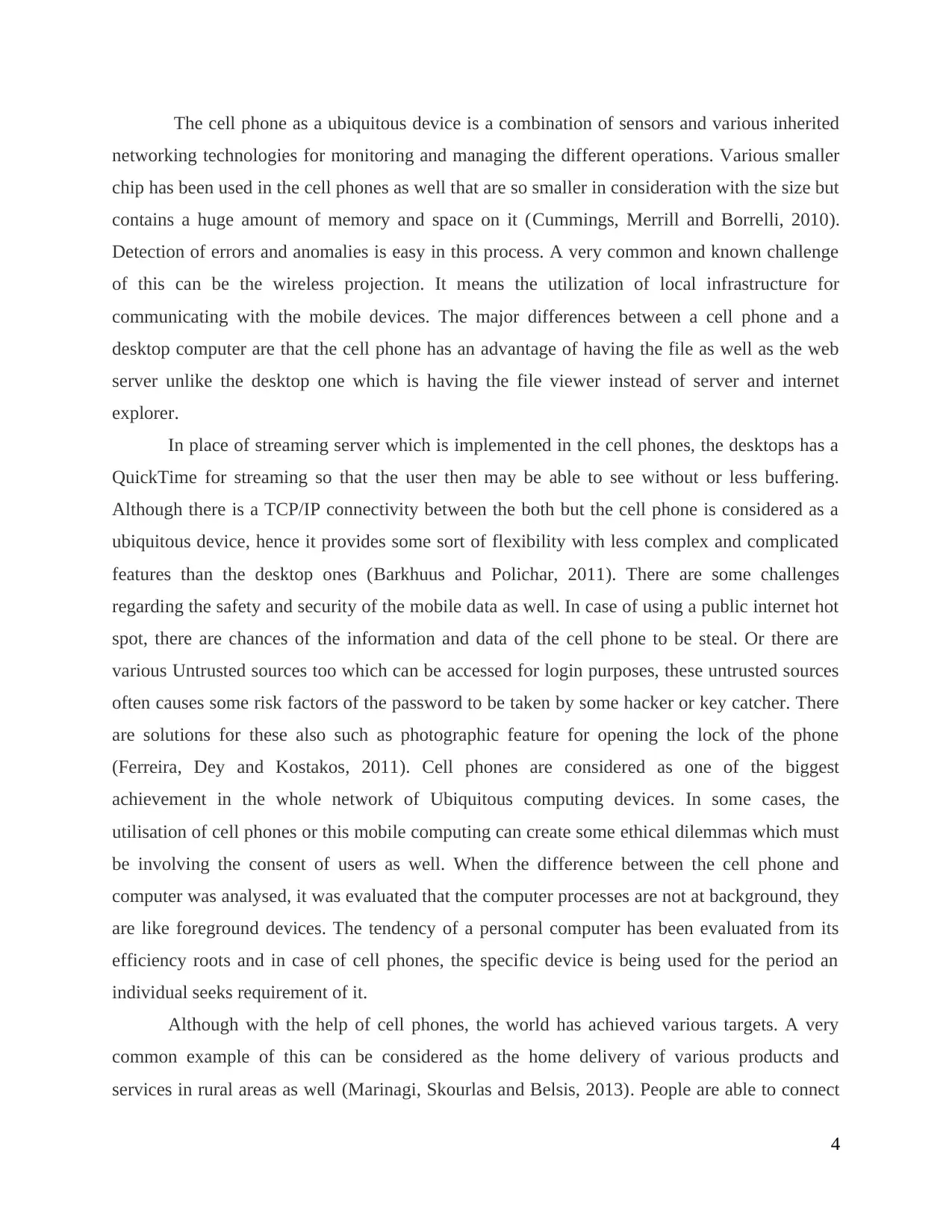
The cell phone as a ubiquitous device is a combination of sensors and various inherited
networking technologies for monitoring and managing the different operations. Various smaller
chip has been used in the cell phones as well that are so smaller in consideration with the size but
contains a huge amount of memory and space on it (Cummings, Merrill and Borrelli, 2010).
Detection of errors and anomalies is easy in this process. A very common and known challenge
of this can be the wireless projection. It means the utilization of local infrastructure for
communicating with the mobile devices. The major differences between a cell phone and a
desktop computer are that the cell phone has an advantage of having the file as well as the web
server unlike the desktop one which is having the file viewer instead of server and internet
explorer.
In place of streaming server which is implemented in the cell phones, the desktops has a
QuickTime for streaming so that the user then may be able to see without or less buffering.
Although there is a TCP/IP connectivity between the both but the cell phone is considered as a
ubiquitous device, hence it provides some sort of flexibility with less complex and complicated
features than the desktop ones (Barkhuus and Polichar, 2011). There are some challenges
regarding the safety and security of the mobile data as well. In case of using a public internet hot
spot, there are chances of the information and data of the cell phone to be steal. Or there are
various Untrusted sources too which can be accessed for login purposes, these untrusted sources
often causes some risk factors of the password to be taken by some hacker or key catcher. There
are solutions for these also such as photographic feature for opening the lock of the phone
(Ferreira, Dey and Kostakos, 2011). Cell phones are considered as one of the biggest
achievement in the whole network of Ubiquitous computing devices. In some cases, the
utilisation of cell phones or this mobile computing can create some ethical dilemmas which must
be involving the consent of users as well. When the difference between the cell phone and
computer was analysed, it was evaluated that the computer processes are not at background, they
are like foreground devices. The tendency of a personal computer has been evaluated from its
efficiency roots and in case of cell phones, the specific device is being used for the period an
individual seeks requirement of it.
Although with the help of cell phones, the world has achieved various targets. A very
common example of this can be considered as the home delivery of various products and
services in rural areas as well (Marinagi, Skourlas and Belsis, 2013). People are able to connect
4
networking technologies for monitoring and managing the different operations. Various smaller
chip has been used in the cell phones as well that are so smaller in consideration with the size but
contains a huge amount of memory and space on it (Cummings, Merrill and Borrelli, 2010).
Detection of errors and anomalies is easy in this process. A very common and known challenge
of this can be the wireless projection. It means the utilization of local infrastructure for
communicating with the mobile devices. The major differences between a cell phone and a
desktop computer are that the cell phone has an advantage of having the file as well as the web
server unlike the desktop one which is having the file viewer instead of server and internet
explorer.
In place of streaming server which is implemented in the cell phones, the desktops has a
QuickTime for streaming so that the user then may be able to see without or less buffering.
Although there is a TCP/IP connectivity between the both but the cell phone is considered as a
ubiquitous device, hence it provides some sort of flexibility with less complex and complicated
features than the desktop ones (Barkhuus and Polichar, 2011). There are some challenges
regarding the safety and security of the mobile data as well. In case of using a public internet hot
spot, there are chances of the information and data of the cell phone to be steal. Or there are
various Untrusted sources too which can be accessed for login purposes, these untrusted sources
often causes some risk factors of the password to be taken by some hacker or key catcher. There
are solutions for these also such as photographic feature for opening the lock of the phone
(Ferreira, Dey and Kostakos, 2011). Cell phones are considered as one of the biggest
achievement in the whole network of Ubiquitous computing devices. In some cases, the
utilisation of cell phones or this mobile computing can create some ethical dilemmas which must
be involving the consent of users as well. When the difference between the cell phone and
computer was analysed, it was evaluated that the computer processes are not at background, they
are like foreground devices. The tendency of a personal computer has been evaluated from its
efficiency roots and in case of cell phones, the specific device is being used for the period an
individual seeks requirement of it.
Although with the help of cell phones, the world has achieved various targets. A very
common example of this can be considered as the home delivery of various products and
services in rural areas as well (Marinagi, Skourlas and Belsis, 2013). People are able to connect
4
⊘ This is a preview!⊘
Do you want full access?
Subscribe today to unlock all pages.

Trusted by 1+ million students worldwide
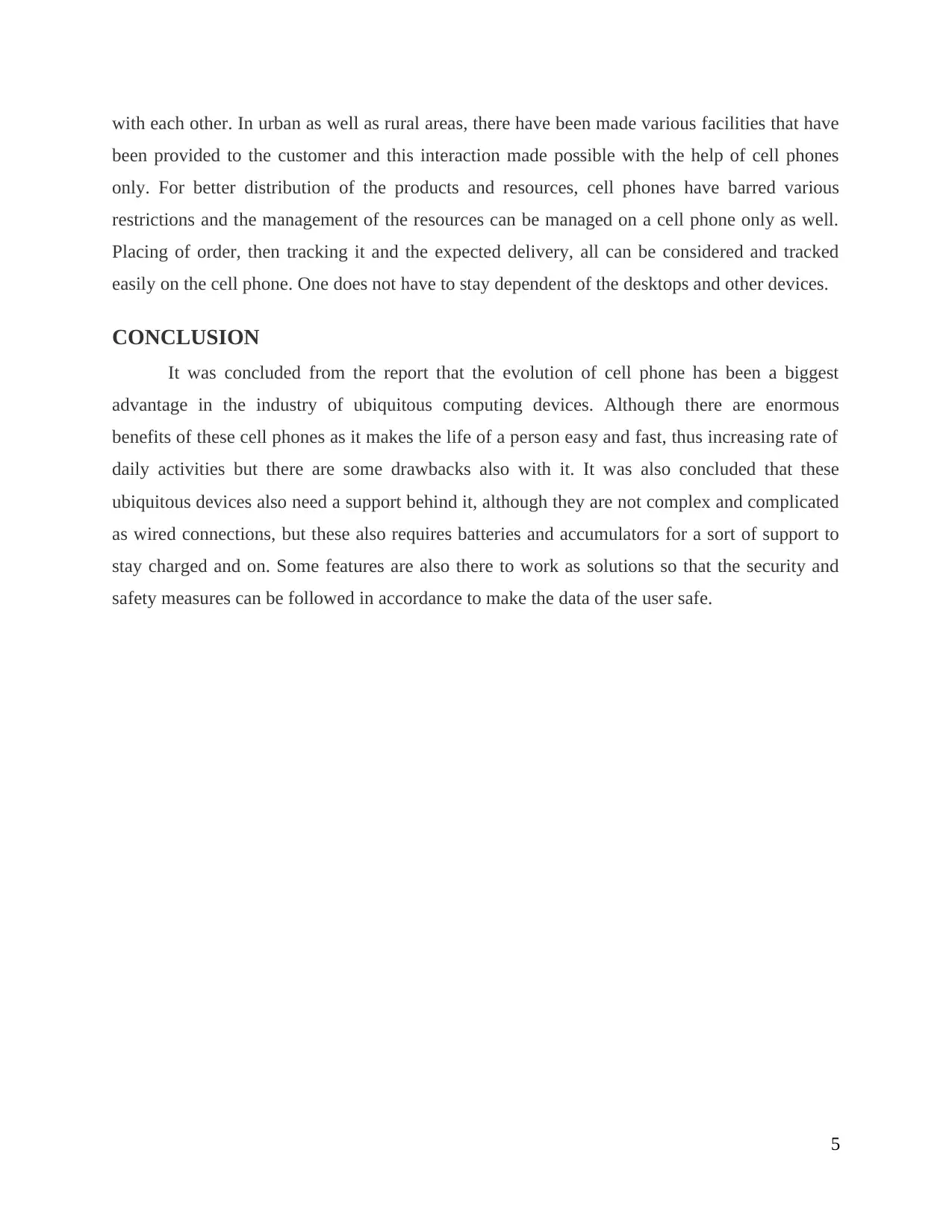
with each other. In urban as well as rural areas, there have been made various facilities that have
been provided to the customer and this interaction made possible with the help of cell phones
only. For better distribution of the products and resources, cell phones have barred various
restrictions and the management of the resources can be managed on a cell phone only as well.
Placing of order, then tracking it and the expected delivery, all can be considered and tracked
easily on the cell phone. One does not have to stay dependent of the desktops and other devices.
CONCLUSION
It was concluded from the report that the evolution of cell phone has been a biggest
advantage in the industry of ubiquitous computing devices. Although there are enormous
benefits of these cell phones as it makes the life of a person easy and fast, thus increasing rate of
daily activities but there are some drawbacks also with it. It was also concluded that these
ubiquitous devices also need a support behind it, although they are not complex and complicated
as wired connections, but these also requires batteries and accumulators for a sort of support to
stay charged and on. Some features are also there to work as solutions so that the security and
safety measures can be followed in accordance to make the data of the user safe.
5
been provided to the customer and this interaction made possible with the help of cell phones
only. For better distribution of the products and resources, cell phones have barred various
restrictions and the management of the resources can be managed on a cell phone only as well.
Placing of order, then tracking it and the expected delivery, all can be considered and tracked
easily on the cell phone. One does not have to stay dependent of the desktops and other devices.
CONCLUSION
It was concluded from the report that the evolution of cell phone has been a biggest
advantage in the industry of ubiquitous computing devices. Although there are enormous
benefits of these cell phones as it makes the life of a person easy and fast, thus increasing rate of
daily activities but there are some drawbacks also with it. It was also concluded that these
ubiquitous devices also need a support behind it, although they are not complex and complicated
as wired connections, but these also requires batteries and accumulators for a sort of support to
stay charged and on. Some features are also there to work as solutions so that the security and
safety measures can be followed in accordance to make the data of the user safe.
5
Paraphrase This Document
Need a fresh take? Get an instant paraphrase of this document with our AI Paraphraser
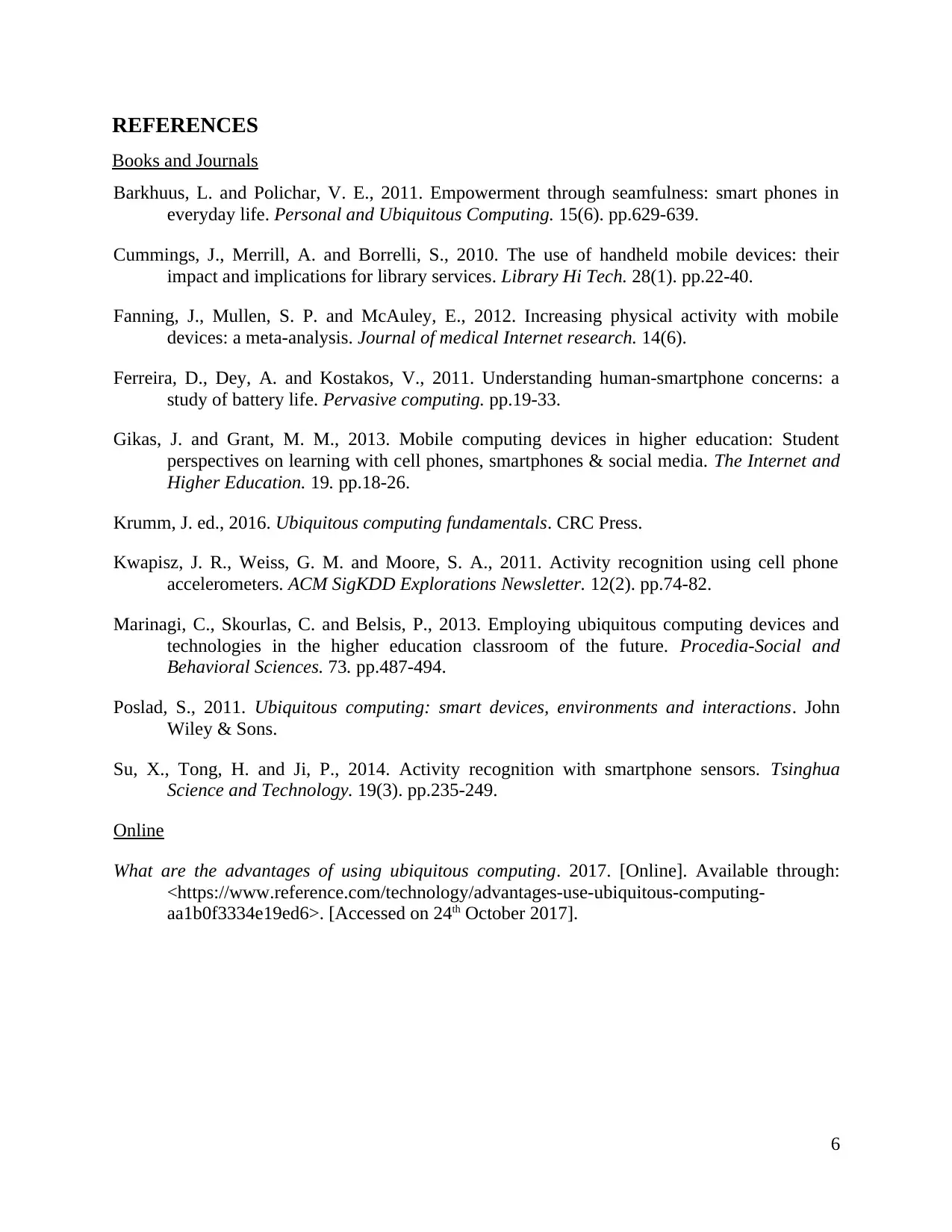
REFERENCES
Books and Journals
Barkhuus, L. and Polichar, V. E., 2011. Empowerment through seamfulness: smart phones in
everyday life. Personal and Ubiquitous Computing. 15(6). pp.629-639.
Cummings, J., Merrill, A. and Borrelli, S., 2010. The use of handheld mobile devices: their
impact and implications for library services. Library Hi Tech. 28(1). pp.22-40.
Fanning, J., Mullen, S. P. and McAuley, E., 2012. Increasing physical activity with mobile
devices: a meta-analysis. Journal of medical Internet research. 14(6).
Ferreira, D., Dey, A. and Kostakos, V., 2011. Understanding human-smartphone concerns: a
study of battery life. Pervasive computing. pp.19-33.
Gikas, J. and Grant, M. M., 2013. Mobile computing devices in higher education: Student
perspectives on learning with cell phones, smartphones & social media. The Internet and
Higher Education. 19. pp.18-26.
Krumm, J. ed., 2016. Ubiquitous computing fundamentals. CRC Press.
Kwapisz, J. R., Weiss, G. M. and Moore, S. A., 2011. Activity recognition using cell phone
accelerometers. ACM SigKDD Explorations Newsletter. 12(2). pp.74-82.
Marinagi, C., Skourlas, C. and Belsis, P., 2013. Employing ubiquitous computing devices and
technologies in the higher education classroom of the future. Procedia-Social and
Behavioral Sciences. 73. pp.487-494.
Poslad, S., 2011. Ubiquitous computing: smart devices, environments and interactions. John
Wiley & Sons.
Su, X., Tong, H. and Ji, P., 2014. Activity recognition with smartphone sensors. Tsinghua
Science and Technology. 19(3). pp.235-249.
Online
What are the advantages of using ubiquitous computing. 2017. [Online]. Available through:
<https://www.reference.com/technology/advantages-use-ubiquitous-computing-
aa1b0f3334e19ed6>. [Accessed on 24th October 2017].
6
Books and Journals
Barkhuus, L. and Polichar, V. E., 2011. Empowerment through seamfulness: smart phones in
everyday life. Personal and Ubiquitous Computing. 15(6). pp.629-639.
Cummings, J., Merrill, A. and Borrelli, S., 2010. The use of handheld mobile devices: their
impact and implications for library services. Library Hi Tech. 28(1). pp.22-40.
Fanning, J., Mullen, S. P. and McAuley, E., 2012. Increasing physical activity with mobile
devices: a meta-analysis. Journal of medical Internet research. 14(6).
Ferreira, D., Dey, A. and Kostakos, V., 2011. Understanding human-smartphone concerns: a
study of battery life. Pervasive computing. pp.19-33.
Gikas, J. and Grant, M. M., 2013. Mobile computing devices in higher education: Student
perspectives on learning with cell phones, smartphones & social media. The Internet and
Higher Education. 19. pp.18-26.
Krumm, J. ed., 2016. Ubiquitous computing fundamentals. CRC Press.
Kwapisz, J. R., Weiss, G. M. and Moore, S. A., 2011. Activity recognition using cell phone
accelerometers. ACM SigKDD Explorations Newsletter. 12(2). pp.74-82.
Marinagi, C., Skourlas, C. and Belsis, P., 2013. Employing ubiquitous computing devices and
technologies in the higher education classroom of the future. Procedia-Social and
Behavioral Sciences. 73. pp.487-494.
Poslad, S., 2011. Ubiquitous computing: smart devices, environments and interactions. John
Wiley & Sons.
Su, X., Tong, H. and Ji, P., 2014. Activity recognition with smartphone sensors. Tsinghua
Science and Technology. 19(3). pp.235-249.
Online
What are the advantages of using ubiquitous computing. 2017. [Online]. Available through:
<https://www.reference.com/technology/advantages-use-ubiquitous-computing-
aa1b0f3334e19ed6>. [Accessed on 24th October 2017].
6

7
⊘ This is a preview!⊘
Do you want full access?
Subscribe today to unlock all pages.

Trusted by 1+ million students worldwide
1 out of 9
Related Documents
Your All-in-One AI-Powered Toolkit for Academic Success.
+13062052269
info@desklib.com
Available 24*7 on WhatsApp / Email
![[object Object]](/_next/static/media/star-bottom.7253800d.svg)
Unlock your academic potential
Copyright © 2020–2025 A2Z Services. All Rights Reserved. Developed and managed by ZUCOL.





